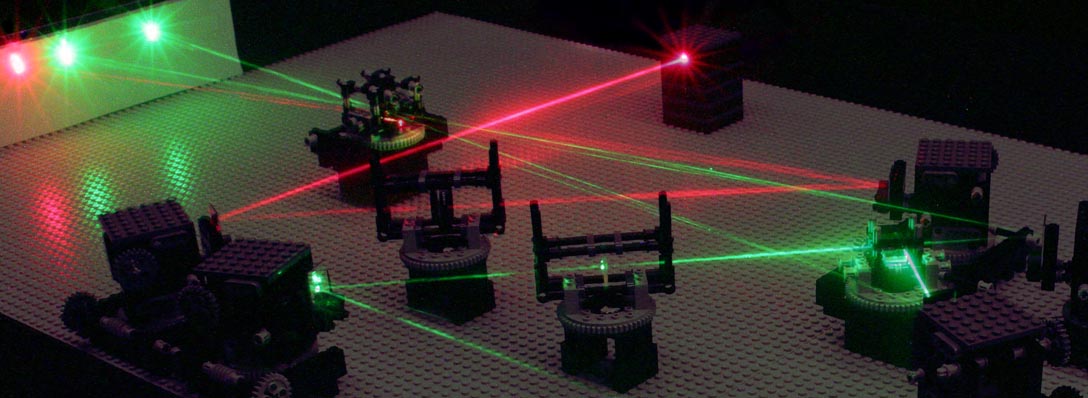Welcome to DU!
The truly grassroots left-of-center political community where regular people, not algorithms, drive the discussions and set the standards.
Join the community:
Create a free account
Support DU (and get rid of ads!):
Become a Star Member
Latest Breaking News
General Discussion
The DU Lounge
All Forums
Issue Forums
Culture Forums
Alliance Forums
Region Forums
Support Forums
Help & Search
Science
Related: About this forumLEGO Block Structures as a Sub-Kelvin Thermal Insulator
From https://www.nature.com/articles/s41598-019-55616-7
LEGO® Block Structures as a Sub-Kelvin Thermal Insulator
Published: 23 December 2019
LEGO® Block Structures as a Sub-Kelvin Thermal Insulator
J. M. A. Chawner, A. T. Jones, M. T. Noble, G. R. Pickett, V. Tsepelin & D. E. Zmeev
Scientific Reports volume 9, Article number: 19642 (2019)
Abstract
We report measurements of the thermal conductance of a structure made from commercial Acrylonitrile Butadiene Styrene (ABS) modules, known as LEGO® blocks, in the temperature range from 70?mK to 1.8?K. A power law for the sample’s thermal conductivity ??= ?{8.7?±?0.3}?×?10?5 T?1.75±0.02?WK?1 m?1 was determined. We conclude that this ABS/void compound material provides better thermal isolation than well-known bulk insulator materials in the explored temperature range, whilst maintaining solid support. LEGO blocks represent a cheap and superlative alternative to materials such as Macor or Vespel. In our setup, <400?nW of power can heat an experimental area of 5?cm2 to over 1?K, without any significant change to the base temperature of the dilution refrigerator. This work suggests that custom-built modular materials with even better thermal performance could be readily and cheaply produced by 3D printing.
Introduction
Low thermal conductivity materials are necessary for thermally isolating cryogenic components. Radiation shield spacers and support rods in dilution refrigerators are good examples of this. These components are useful for all cryogenics but especially for the current progression of quantum computing, which relies on isolated low temperatures for operation and coherence. Certain plastic materials, such as Vespel, have reasonably low thermal conductivities1, but large volumes can be costly. In this work, we show that a modular Acrylonitrile Butadiene Styrene (ABS) solid/void structure assembled from commercially available LEGO® blocks exhibit effective thermal conductivity even lower than industry-standard bulk materials, whilst offering good mechanical properties. The individual blocks readily allow affordable and repeatable large volume customization. Thermal conduction along the structure is difficult to predict from the properties of pure ABS material, since the internal thermal paths are complicated and include the solid-solid contact thermal resistance between the blocks. The results presented are characteristic of a modular ABS/void composite material constructed from typical LEGO elements.
[...]
Published: 23 December 2019
LEGO® Block Structures as a Sub-Kelvin Thermal Insulator
J. M. A. Chawner, A. T. Jones, M. T. Noble, G. R. Pickett, V. Tsepelin & D. E. Zmeev
Scientific Reports volume 9, Article number: 19642 (2019)
Abstract
We report measurements of the thermal conductance of a structure made from commercial Acrylonitrile Butadiene Styrene (ABS) modules, known as LEGO® blocks, in the temperature range from 70?mK to 1.8?K. A power law for the sample’s thermal conductivity ??= ?{8.7?±?0.3}?×?10?5 T?1.75±0.02?WK?1 m?1 was determined. We conclude that this ABS/void compound material provides better thermal isolation than well-known bulk insulator materials in the explored temperature range, whilst maintaining solid support. LEGO blocks represent a cheap and superlative alternative to materials such as Macor or Vespel. In our setup, <400?nW of power can heat an experimental area of 5?cm2 to over 1?K, without any significant change to the base temperature of the dilution refrigerator. This work suggests that custom-built modular materials with even better thermal performance could be readily and cheaply produced by 3D printing.
Introduction
Low thermal conductivity materials are necessary for thermally isolating cryogenic components. Radiation shield spacers and support rods in dilution refrigerators are good examples of this. These components are useful for all cryogenics but especially for the current progression of quantum computing, which relies on isolated low temperatures for operation and coherence. Certain plastic materials, such as Vespel, have reasonably low thermal conductivities1, but large volumes can be costly. In this work, we show that a modular Acrylonitrile Butadiene Styrene (ABS) solid/void structure assembled from commercially available LEGO® blocks exhibit effective thermal conductivity even lower than industry-standard bulk materials, whilst offering good mechanical properties. The individual blocks readily allow affordable and repeatable large volume customization. Thermal conduction along the structure is difficult to predict from the properties of pure ABS material, since the internal thermal paths are complicated and include the solid-solid contact thermal resistance between the blocks. The results presented are characteristic of a modular ABS/void composite material constructed from typical LEGO elements.
[...]
More at link.
InfoView thread info, including edit history
TrashPut this thread in your Trash Can (My DU » Trash Can)
BookmarkAdd this thread to your Bookmarks (My DU » Bookmarks)
5 replies, 952 views
ShareGet links to this post and/or share on social media
AlertAlert this post for a rule violation
PowersThere are no powers you can use on this post
EditCannot edit other people's posts
ReplyReply to this post
EditCannot edit other people's posts
Rec (2)
ReplyReply to this post
5 replies
 = new reply since forum marked as read
Highlight:
NoneDon't highlight anything
5 newestHighlight 5 most recent replies
= new reply since forum marked as read
Highlight:
NoneDon't highlight anything
5 newestHighlight 5 most recent replies
LEGO Block Structures as a Sub-Kelvin Thermal Insulator (Original Post)
sl8
Dec 2019
OP
dweller
(23,641 posts)1. experiment not replicable
since ![]() would be a variable with the observer ...
would be a variable with the observer ...
![]()
✌🏼
oh well you fixed it ![]()
Those smilies really wreak havoc with text which contains parentheses.
In case anyone's wondering, this is the original sentence:
A power law for the sample’s thermal conductivity ??= ?![]() 8.7?±?0.3)?×?10?5 T?1.75±0.02?WK?1 m?1 was determined.
8.7?±?0.3)?×?10?5 T?1.75±0.02?WK?1 m?1 was determined.
🙏🏻
quietly gathering my legos around me ...
✌🏼
caraher
(6,278 posts)4. Great for optics too
LEGO bricks are remarkably stable - they've been used to build interferometers

sl8
(13,786 posts)5. Very cool. Thanks! n/t